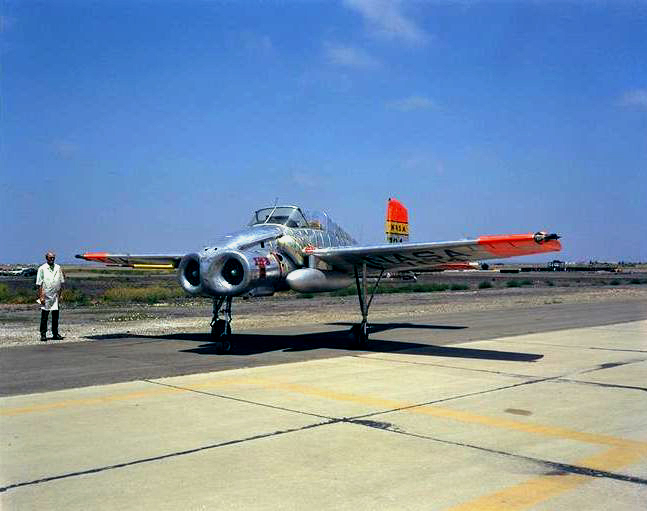- Bell X-14
caption = Bell Type 68 VTOL
type = ExperimentalVTOL
manufacturer =Bell Aircraft
designer =
first flight =19 February 1957
introduced =
retired =29 May 1981
produced =
primary user =NASA
more users =United States Air Force
number built = 1
status = Out of service
unit cost =
developed from =
variants with their own articles =The Bell X-14 (Bell Type 68) was an experimental
VTOL aircraft flown in theUnited States in the 1950s. The main objective of the project was to demonstrate horizontal and vertical takeoff, hover, transition to forward flight, and vertical landing.Development
Bell constructed the X-14 as an open-
cockpit , all-metalmonoplane . It was powered by twoArmstrong Siddeley Viperturbojet engine s equipped with thrust deflectors sited at the aircraft's centre of gravity. The engines are fixed in position; transition from vertical to horizontal flight is achieved with a system of movable vanes that control the direction of engine thrust. Top speed was 180 miles per hour with a service ceiling of 20,000 feet. The X-14 was designed using existing parts from two Beech aircraft: wings, ailerons, and landing gear of a Bonanza and the tailcone andempennage of a T-34.Operational history
The X-14 first flew on
19 February 1957 as a vertical takeoff, hover, then vertical landing. The first transition from hover to horizontal flight occurred on24 May 1958 . In 1959, its Viper engines were replaced withGeneral Electric J85 engines. That year the aircraft was also delivered to theNASA Ames Research Center as the X-14A. It served as a test aircraft withNASA until 1981.The X-14 project provided a great deal of data on VTOL (Vertical TakeOff and Landing) type aircraft. The X-14A also was used by NASA for research on lunar landing maneuvers. The X-14A aircraft flight control system was similar to the one proposed for the
Lunar Module .Neil Armstrong , the first man to walk on the Moon, once flew it as a lunar-landing trainer.In 1971, the X-14A was fitted with new engines (General Electric J85-GE-19) and redesignated the X-14B. An onboard computer and digital fly-by-wire control system were also installed to enable emulation of landing characteristics of other VTOL aircraft.
The X-14B was used in this test role until it was damaged beyond repair in a landing accident on
29 May ,1981 . At the time, there were plans to develop an X-14C with an enclosed cockpit. There were also plans for an X-14T trainer. None of these further versions got beyond the planning stage.During all of its years of service, the X-14 was flown by over 25 pilots with no serious incidents or injuries. It was the only open cockpit X-plane.
Aircraft serial numbers
Although there was only one airframe, it kept changing serial numbers with every major upgrade.
*X-14 - "USAF" "56-4022"
*X-14A - "NASA 234" (N234NA).
*X-14B - "NASA 704" (N704NA).urvivor
The X-14 was rescued from the scrap yard in 1999 and is currently undergoing renovation as part of a private collection in western
Indiana . The collection is displayed at the Ropkey Armor Museum. Fact|date=August 2007pecifications (X-14A)
aircraft specifications
plane or copter?=plane
jet or prop?=jet
ref=
crew=1
capacity=
payload main=
payload alt=
length main= 25 ft 0 in
length alt= 7.62 m
span main= 34 ft 10 in
span alt= 10.36 m
height main= 8 ft 0 in
height alt= 2.40 m
area main=
area alt=
airfoil=
empty weight main=
empty weight alt=
loaded weight main= 3,100 lb
loaded weight alt= 1,406 kg
useful load main=
useful load alt=
max takeoff weight main= 4,269 lb
max takeoff weight alt= 1,936 kg
more general=
engine (jet)=Armstrong Siddeley Viper 8
type of jet=Turbojet
number of jets= 2
thrust main= 1,750 lbf
thrust alt= 7.8 kN
thrust original=
afterburning thrust main=
afterburning thrust alt=
engine (prop)=1
type of prop=
number of props=1
power main=
power alt=
power original=
max speed main= 172 mph
max speed alt= 277 km/h
cruise speed main=
cruise speed alt=
stall speed main=
stall speed alt=
never exceed speed main=
never exceed speed alt=
range main= 300 miles
range alt= 482 km
ceiling main= 20,000 ft
ceiling alt= 6,096 m
climb rate main=
climb rate alt=
loading main=
loading alt=
thrust/weight= 1:0.9
power/mass main=
power/mass alt=
more performance=
armament=
avionics=ee also
*
List of experimental aircraft References
Wikimedia Foundation. 2010.

